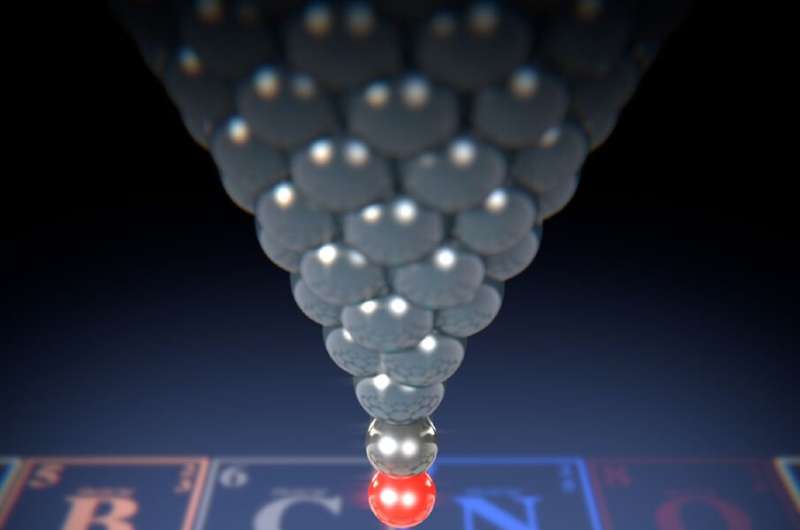Individual impurity atoms detectable in graphene

A team including physicists from the University of Basel has succeeded in using atomic force microscopy to obtain clear images of individual impurity atoms in graphene ribbons. Thanks to the forces measured in the graphene's two-dimensional carbon lattice, they were able to identify boron and nitrogen for the first time, as the researchers report in the journal Science Advances.
Graphene is made of a two-dimensional layer of carbon atoms arranged in a hexagonal lattice. The strong bonds between the carbon atoms make graphene extremely stable yet flexible. It is also an excellent electrical conductor through which electricity can flow with almost no loss.
Graphene's distinctive properties can be further expanded by incorporating impurity atoms in a process known as "doping". The impurity atoms cause local changes of the conduction that, for example, allow graphene to be used as a tiny transistor and enable the construction of circuits.
In a collaboration between scientists from the University of Basel and the National Institute for Material Science in Tsukuba in Japan, Kanazawa University and Kwansei Gakuin University in Japan, and Aalto University in Finland, the researchers specifically created and examined graphene ribbons containing impurity atoms.
They replaced particular carbon atoms in the hexagonal lattice with boron and nitrogen atoms using surface chemistry, by placing suitable organic precursor compounds on a gold surface. Under heat exposure up to 400°C, tiny graphene ribbons formed on the gold surface from the precursors, including impurity atoms at specific sites.
Scientists from the team led by Professor Ernst Meyer from the Swiss Nanoscience Institute and the University of Basel's Department of Physics examined these graphene ribbons using atomic force microscopy (AFM). They used a carbon monoxide functionalized tip and measured the tiny forces that act between the tip and the individual atoms.
This method allows even the smallest differences in forces to be detected. By looking at the different forces, the researchers were able to map and identify the different atoms. "The forces measured for nitrogen atoms are greater than for a carbon atom," explains Dr. Shigeki Kawai, lead author of the study and former postdoc in Meyer's team. "We measured the smallest forces for the boron atoms." The different forces can be explained by the different proportion of repulsive forces, which is due to the different atomic radii.
Computer simulations confirmed the readings, proving that AFM technology is well-suited to conducting chemical analyses of impurity atoms in the promising two-dimensional carbon compounds.
More information: "Multiple heteroatom substitution to graphene nanoribbon" Science Advances (2018). DOI: 10.1126/sciadv.aar7181 , advances.sciencemag.org/content/4/4/eaar7181
Journal information: Science Advances
Provided by University of Basel





















